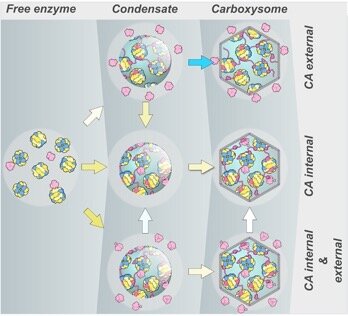Rubisco is arguably the most abundant—and most important—protein on Earth. This enzyme drives photosynthesis, the process that plants use to convert sunlight into energy to fuel crop growth and yield. Rubisco’s role is to capture and fix carbon dioxide (CO2) into sugar that fuels the plant’s activities. However, as much as Rubisco benefits plant growth, it also can operate at a notoriously slow pace that creates a hindrance to photosynthetic efficiency.
About 20 percent of the time Rubisco fixes oxygen (O2) molecules instead of CO2, costing the plant energy that could have been utilized to create yield. This time- and energy-consuming process is called photorespiration, where the plant sends its enzymes through three different compartments within the plant cell.
“However, many photosynthetic organisms have evolved mechanisms to overcome some of Rubisco’s limitations,” said Ben Long who led this recent study published in PNAS for a research project called Realizing Increased Photosynthetic Efficiency (RIPE). RIPE, which is led by Illinois in partnership with the Australian National University (ANU), is engineering crops to be more productive by improving photosynthesis.
“Among these organisms are microalgae and cyanobacteria from aquatic environments, which have efficiently functioning Rubisco enzymes sitting inside liquid protein droplets and protein compartments called pyrenoids and carboxysomes,” said lead researcher Long from the ANU Research School of Biology.
How these protein compartments assist in the Rubisco function is not entirely known. The team from ANU aimed to find the answer by using a mathematical model that focused on the chemical reaction Rubisco carries out. As it collects CO2 from the atmosphere, Rubisco also releases positively charged protons.
“Inside Rubisco compartments, these protons can speed up Rubisco by increasing the amount of CO2 available. The protons do this by helping the conversion of bicarbonate into CO2,” said Long. “Bicarbonate is the major source of CO2 in aquatic environments and photosynthetic organisms that use bicarbonate can tell us a lot about how to improve crop plants.”
The mathematical model gives the ANU team a better idea as to why these special Rubisco compartments might improve the enzyme’s function and it also gives them more insight into how they may have evolved. One hypothesis from the study suggests that periods of low CO2 in the earth’s ancient atmosphere may have been the trigger for the cyanobacteria and microalgae to evolve these specialized compartments, while they might also be beneficial for organisms that grow in dim light environments.
ANU members of the Realizing Increased Photosynthetic Efficiency (RIPE) project are trying to build these specialized Rubisco compartments in crop plants to assist in increasing yield.
“The outcomes of this study,” explained Long, “provide an insight into the correct function of specialized Rubisco compartments and give us a better understanding of how we expect them to perform in plants.”
Repairing the photosynthetic enzyme Rubisco
More information:
Benedict M. Long et al, Rubisco proton production can drive the elevation of CO2 within condensates and carboxysomes, Proceedings of the National Academy of Sciences (2021). DOI: 10.1073/pnas.2014406118
Provided by
University of Illinois at Urbana-Champaign
Citation:
Rubisco proton production can enhance carbon dioxide acquisition (2021, May 24)
retrieved 24 May 2021
from https://phys.org/news/2021-05-rubisco-proton-production-carbon-dioxide.html
This document is subject to copyright. Apart from any fair dealing for the purpose of private study or research, no
part may be reproduced without the written permission. The content is provided for information purposes only.



